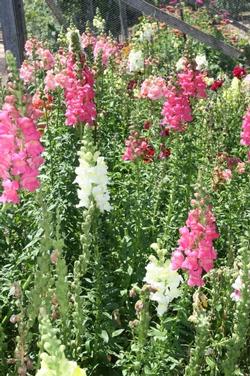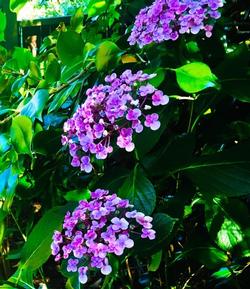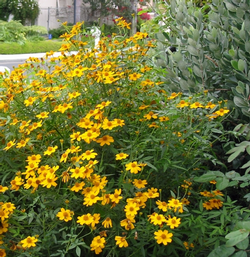Grow your own bouquets
-
For Gorgeous Floral Arrangements and Improved Mental Health, Add a Cutting Garden to Your Landscape
 Snapdragons growing in the cutting garden at Filoli Photo: Jill Clardy, Flickr
Snapdragons growing in the cutting garden at Filoli Photo: Jill Clardy, FlickrAccording to behavioral research conducted at Rutgers University, flowers are nature's way of providing us with a simple way to improve emotional health. They trigger happy emotions, heighten feelings of life satisfaction, and affect social behavior in a positive manner far beyond what is normally believed.
"Is burying your head in a just-picked garden bouquet and inhaling its perfume a joy-inducing experience?" asks Debra Prinzing, author of "The 50 Mile Bouquet: Seasonal, Local and Sustainable Flowers."
According to the Rutgers researchers, it certainly seems to be the case for many of us.
"That clutch of gerbera daisies or tulips from the supermarket may appear picture-perfect, yet it feels disconnected from the less-than-perfect (but incredibly romantic) flowers growing in your own backyard," says Prinzing.Where do those store-bought flowers come from?
Sixty-eight percent of flowers sold in the U.S. are imported — Colombia leads the group, followed by Ecuador, Netherlands, Canada, and Mexico. That's a lot of air miles for your bouquet of blooms, and it certainly isn't very "green" — especially when there are umpteen purveyors selling locally grown flowers. Better yet, you can do it yourself.Beyond bouquets: many reasons to grow your own
Growing your own flowers allows you to stay in tune with and appreciate the seasons. In addition to being food for the soul, garden-grown flowers delight the senses with visual interest and heady fragrance. The flowers you grow for cutting can be integrated into your overall garden, mixed in with your food crops, or tucked away in an area dedicated for just this purpose.
Some flowers can be used in cooking or preserved to savor for months to come. They can attract and support bees and other pollinators and provide food and habitats for birds and beneficial insects. The opportunity to share our bounty with family and friends multiplies the enjoyment.For all of the plants and varieties described, deadheading is the best way to ensure continuous
blooms into (and even all the way through) autumn. Make it a point to patrol your garden, pruners in hand, a couple of times each week to remove spent and fading flowers.
Dazzling summer bloomers
Here are some top-performing plants that bloom in summer. Most flowering plants need six to eight hours of sun daily to produce blooms, along with healthy soil and good drainage. Most important is selecting the right type of plant for your location.
- Stunning cut flowers: black-eyed Susan (Rudbeckia), clematis, dahlias, foxglove, hydrangeas, roses, sunflowers, and zinnias
 Hydrangeas come in many colors and make stunning, long-lasting cut flowers. They also dry nicely to use in arrangements later. Photo: Jane Scurich
Hydrangeas come in many colors and make stunning, long-lasting cut flowers. They also dry nicely to use in arrangements later. Photo: Jane Scurich - Long blooming season: Catmint (Nepeta), geraniums (Pelargonium), hydrangeas, lantana, nasturtium, penstemon, Peruvian lilies (Alstromeria), red hot poker (Kniphofia uvaria), roses, and sage (Salvia)
- Attract birds, bees, and/or butterflies: Asters, campanula, cape plumbago (Plumbago auriculata), catmint, clarkia, coreopsis, lamb's ear (Stachys byzantinas), lantana, lobelia, nicotiana, roses, sage, and verbena
- Low water use: Coneflowers (Echinacea), cape plumbago, coreopsis, lantana, lavender, sage, statice (Limonium sinuatum), windflower (Gaura lindheimeri), and yarrow (Achillea)
- Deer resistant: Aster, catmint, coneflowers, dahlias, foxglove, lantana, lavender, penstemon, Russian sage (Perovskia atriplicifolia), sage, and yarrow
- Dries well: Hydrangeas, lavender, roses, scabiosa, statice, and yarrow
A word about roses
While roses don't fit into the low water use or deer-resistant categories — and they are prone (depending on variety) to some pests and diseases — they can produce blossoms nearly nonstop from April to November with little care other than watering and removing spent blooms. And, as deciduous shrubs, they can last for decades. That's a pretty good return on your investment.
In general, floribunda, polyantha and shrub-type roses produce lots of blossoms versus hybrid tea types, and newer cultivars are much more disease resistant. Some favorites are 'La Marne', a prolific bloomer with unique cerise pink blooms blushed white. 'Sally Holmes' puts out flamboyant trusses of blooms that resemble hydrangeas. Sweet-smelling 'Westerland' is adorned with a swirl of sunset-colored blossoms, and 'Graham Thomas' is covered with bountiful lemon yellow-cupped blooms, as is the powerfully scented 'Julia Child.'Late-summer and fall bloomers
For late summer/fall flowers, these plants offer long-lasting blooms that stand up to the heat: Bright yellow daisy-like flowers bloom on Tagetes lemmonii, a sprawling evergreen shrub. Photo: PlantMaster
Bright yellow daisy-like flowers bloom on Tagetes lemmonii, a sprawling evergreen shrub. Photo: PlantMaster- Pincushion flower (Scabiosa atropurpurea)
- Sage (Salvia)
- Gloriosa daisy/black-eyed Susan (Rudbeckia hirta)
- Yarrow (Achillea)
- Garden verbena (Verbena x hybrida)
- Mexican marigold (Tagetes lemmonii)
Keeping bouquets fresh
Here's how to keep fresh cut flowers alive longer.
So, go local and plant some flowers in your own garden; you'll be able to enjoy safe and sustainable blooms knowing exactly where they came from.
Original articles by Nanette Londeree, Jennifer Kinion and Jane Scurich for the Marin IJ.
Edited by Jane Scurich



